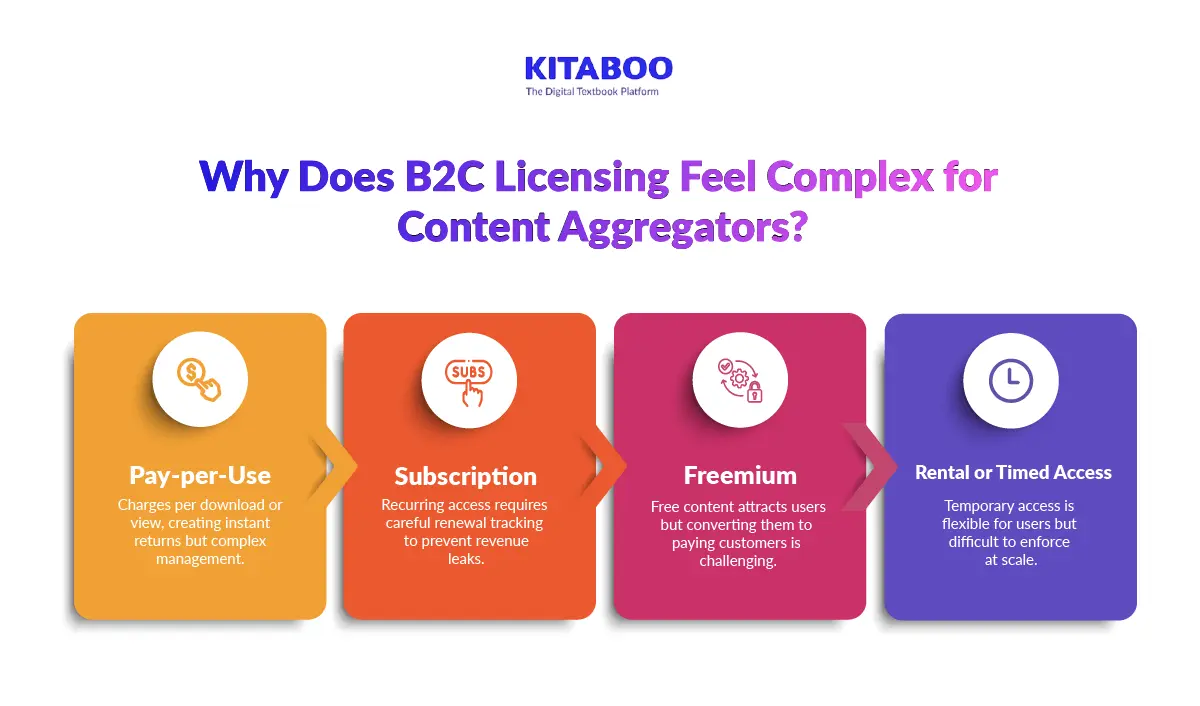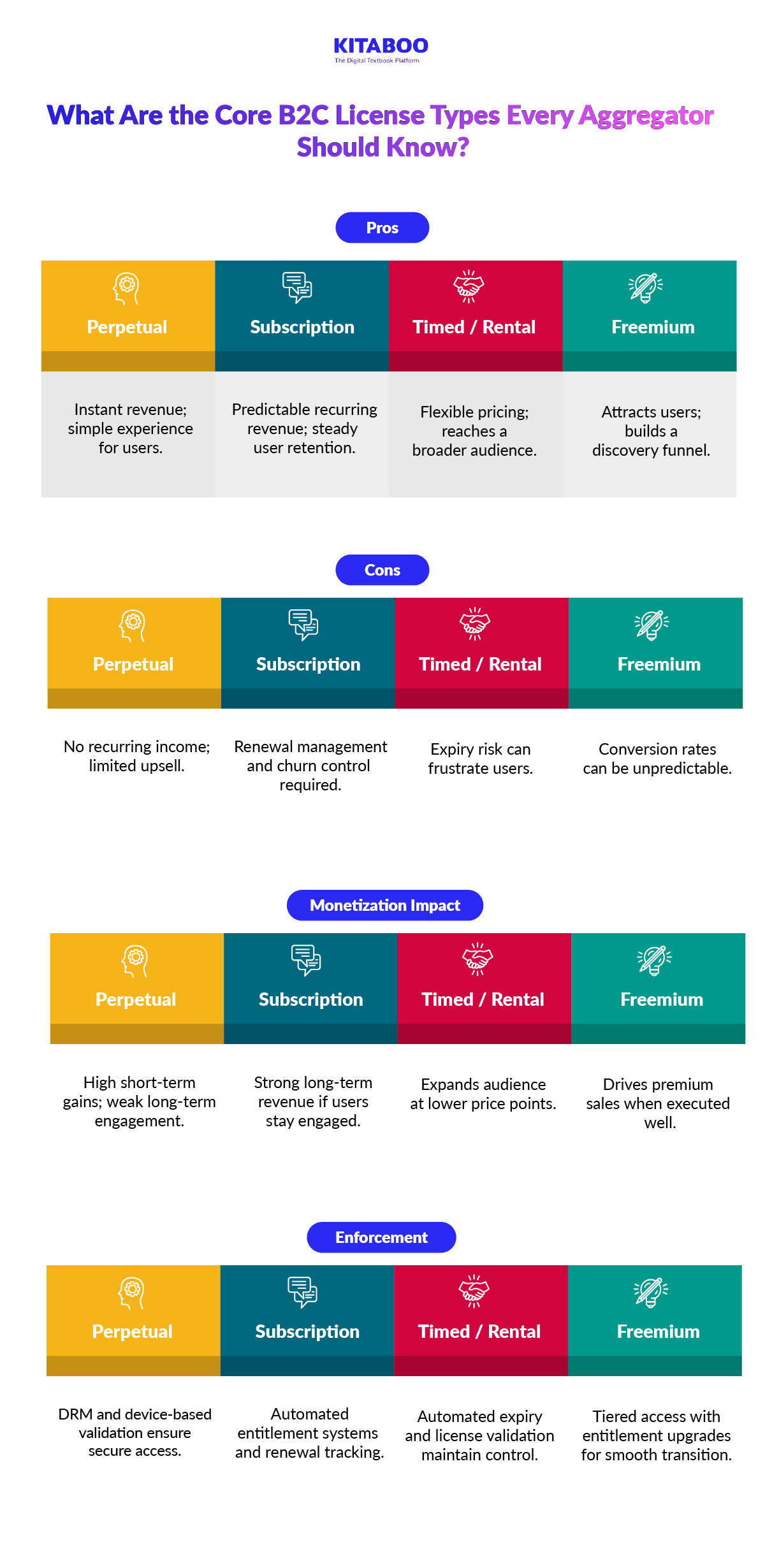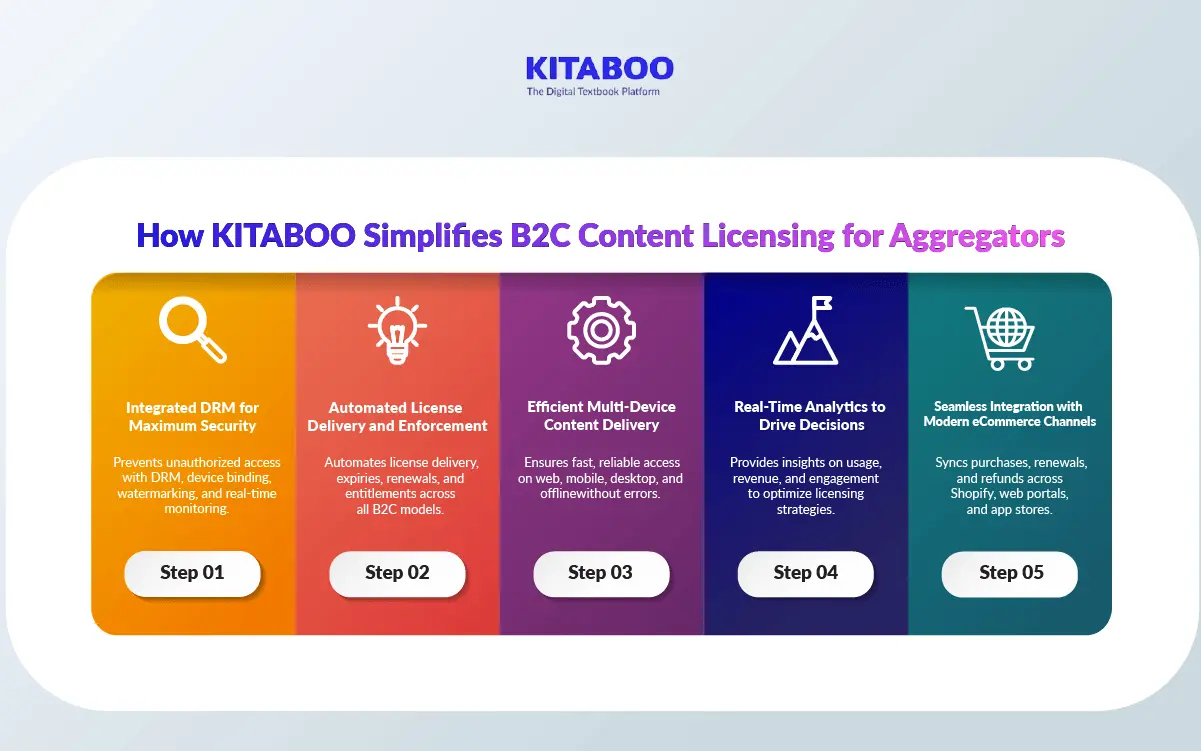
Everything you need to know about B2C Content Licensing
Summarize this blog with your favorite AI:
Everything you need to know about B2C Content Licensing – TL;DR
Content licensing can be complex due to multiple license models, access controls, and eCommerce integration. Mismanaged licensing can lead to revenue loss, frustrated users, and operational challenges for aggregators.
Understanding core license types and their monetization impact is critical for scaling B2C operations efficiently.
Platforms like KITABOO simplify these challenges. They secure content with DRM, ensure multi-device access, and provide real-time analytics. Proper management reduces revenue leakage, improves user experience, and enables aggregators to scale confidently.
Quick Summary Table: Core Content Licensing Insights
| Aspect | Key Points |
|---|---|
| License Complexity | Multiple models create confusion: pay-per-use, subscription, freemium, and rental. |
| Common Pain Points | Unauthorized access, delivery issues, and misaligned eCommerce integration. |
| Core License Types | Perpetual, subscription, timed/rental, freemium. |
| Pros & Cons | Perpetual: high upfront revenue, no recurring income; Subscription: recurring revenue, churn risk; Rental: flexible, temporary access; Freemium: attracts users, conversion risk. |
| Enforcement Challenges | Managing entitlements, renewals, expiries, and access controls at scale. |
| Benefits of Proper Management | Revenue protection, improved user experience, operational efficiency, and scalability. |
| Key Takeaway | Understanding license types and enforcing them systematically is critical for success. |
For many content aggregators, B2C content licensing promised growth and freedom. It seemed simple at first. Create great content, reach readers directly, and earn more.
Then reality set in.
Managing pricing, security, user access, and licenses became a constant struggle. Different models created more confusion than clarity. What should have unlocked new revenue turned into missed opportunities and frustration.
The problem isn’t the lack of demand. It’s the complexity of managing B2C content licensing at scale. Today, it stands as one of the biggest challenges for aggregators trying to scale without losing control.
Why Does B2C Licensing Feel So Complex for Content Aggregators?
B2C content licensing allows publishers or aggregators to sell digital content directly to consumers. It defines how users can access, use, and share the content.
Many content aggregators entered the B2C space expecting simplicity. The goal was to expand reach and build direct relationships with readers. Yet, they now admit that digital licensing has become their biggest operational headache. Instead of boosting revenue, it often leads to missed opportunities and confusion.
The real struggle lies in choosing and managing the right monetization model. Every approach sounds promising on paper, but each adds its own layer of complexity. Below are the four models that create the most confusion and demand the most control.
1. Pay-per-Use
This model charges readers for each download, chapter, or viewing. It offers instant returns and works well for specialized or premium content.
But it can frustrate users who prefer continuous access. For aggregators, managing microtransactions, refunds, and per-title entitlements quickly becomes a logistical challenge.
2. Subscription
Here, users pay monthly or annually for unlimited access to a library or collection. It brings predictable income but requires careful renewal management.
Aggregators must track active users, handle expirations, and prevent unauthorized logins. Without automation, revenue leaks become inevitable.
3. Freemium
Freemium models attract large audiences by offering partial or preview access for free. The challenge lies in converting free users into paying ones.
Aggregators need clear upgrade paths and seamless entitlement changes when users move from free to paid. Poor execution often leads to lost conversions and inconsistent experiences.
4. Rental or Timed Access
This model grants access for a fixed duration, such as a 7-day or 30-day period. It’s flexible and consumer-friendly, but difficult to manage at scale.
Aggregators must enforce precise expiry times and handle renewals without disrupting the reading experience. Any delay or error in license updates can damage user trust.
What Are the Core B2C License Types Every Aggregator Should Know?
Understanding license types is essential for success in B2C content licensing. Each model impacts revenue, access, and user experience differently. Choosing the right combination helps aggregators grow without losing control.
1. Perpetual License
A perpetual license gives users lifetime access after one purchase. It is simple and familiar for consumers. Aggregators receive full payment upfront, improving short-term revenue.
But there is no recurring income or upgrade opportunity. In B2C content licensing, this model works best for fixed or reference materials.
2. Subscription License
A subscription license offers continuous access for a monthly or yearly fee. It creates predictable recurring revenue and builds stronger user engagement.
Content Aggregators must manage renewals and prevent churn carefully. When executed well, it becomes one of the most stable models in content licensing.
3. Timed or Rental License
This model grants temporary access, often for a week or a month. It appeals to users who want flexibility without full ownership.
Aggregators must track expiry times and handle renewals automatically. Timed licensing helps reach a wider audience but demands strong control systems in content licensing.
4. Freemium License
A freemium license provides limited access for free and charges for full content. It helps attract large audiences and boosts brand visibility.
The challenge is converting free users into paying customers. Clear upgrade options and seamless entitlement changes are key to success with freemium models.
What Are the Biggest Pain Points in B2C Content Licensing?
Even with the right license types, B2C content licensing can quickly become a nightmare for aggregators. A single misstep can lead to lost revenue, frustrated users, and damaged credibility.
1. Preventing Unauthorized Access or Sharing
Account sharing, piracy, and leaked credentials can drain revenue overnight. One unlocked copy can be copied and distributed globally in minutes. Publishers demand protection, and failing to secure content can end partnerships.
Without strict Digital Rights Management and real-time monitoring, your licenses lose meaning. Your content becomes vulnerable to misuse and piracy.
2. Delivering Content Efficiently to End Devices
Slow or failed delivery frustrates users and triggers refunds. Inconsistent formats can break access across platforms. Offline reading expectations complicate license enforcement.
If content does not reach users instantly and reliably, trust is lost. Delays, crashes, or corrupted files mean lost engagement and lost income, even with the best pricing models.
3. Aligning Licenses with Modern eCommerce Channels
Shopify stores, web portals, and app stores each have strict rules and payment flows. Challenges of eCommerce integration can derail your progress. Misaligned licenses lead to failed purchases, expired access, or refund disputes.
Regional pricing errors and delayed entitlement updates frustrate users. Every broken flow is revenue lost and a user likely to churn. Without automated integration, scaling content licensing becomes nearly impossible.
How KITABOO Simplifies B2C Content Licensing for Aggregators?
B2C content licensing can overwhelm aggregators with complex models, security risks, and operational gaps. KITABOO provides a complete solution to simplify every step.
1. Integrated DRM for Maximum Security
Aggregators struggle to prevent unauthorized access and sharing. KITABOO solves this with strong Digital Rights Management. The platform security ensures content cannot be shared or copied illegally.
Real-time monitoring alerts teams to suspicious access activity immediately. Aggregators maintain control over every title, every user, and every device. This eliminates revenue leakage and protects publisher relationships.
2. Automated License Delivery and Enforcement
Manual license management is time-consuming and error-prone. KITABOO automates license delivery for perpetual, subscription, rental, and freemium models. Entitlements, expiries, and renewals happen automatically, ensuring users always get the right access.
Aggregators can scale operations without risking errors or delayed access. Automation reduces operational stress and ensures revenue is captured accurately.
3. Efficient Multi-Device Content Delivery
Users expect fast, reliable access across web, mobile, and desktop. KITABOO ensures content reaches all devices seamlessly. Offline reading also works without compromising license control.
Optimized formats and secure deliveries prevent delays and file corruption. Aggregators provide consistent experiences to consumers, improving satisfaction and reducing refunds. Reliable content delivery directly supports monetization and user retention.
4. Real-Time Analytics to Drive Decisions
Aggregators often lack visibility into license performance and user behavior. KITABOO provides real-time analytics on activations, engagement, and revenue.
Teams can also spot underperforming titles, optimize pricing, and identify revenue risks quickly. These insights help aggregators make data-driven decisions. They can improve licensing strategies and ensure every license contributes to growth.
5. Seamless Integration with Modern eCommerce Channels
Modern eCommerce channels have strict rules for payments and subscriptions. KITABOO integrates with eCommerce channels like Shopify stores, web portals, and app stores easily.
Purchases, renewals, and refunds sync instantly with entitlements. Aggregators can manage regional pricing and updates without errors. This ensures smooth user experience, protects revenue, and makes scaling B2C content licensing simple.
Conclusion
B2C content licensing does not have to be complex. Understanding license types, managing access, and aligning with modern eCommerce are critical for revenue growth. Many aggregators struggle with security, delivery, and operational gaps, which can quickly turn opportunities into losses.
KITABOO simplifies every step. It secures content, automates license delivery, ensures seamless multi-device access, and provides real-time insights. Aggregators gain full control, protect revenue, and scale B2C licensing confidently.
Take the next step today. Book an exclusive demo. See how KITABOO can transform your content licensing into a reliable, profitable, and stress-free process. Don’t let complex licensing block your growth.
FAQs
The core types include perpetual, subscription, timed/rental, and freemium licenses. Each has different benefits, monetization potential, and enforcement requirements.
Multiple pricing models, access rules, and platform integrations create complexity. Aggregators must manage renewals, expiries, entitlements, and compliance.
Subscription licenses offer continuous access for recurring payments. Rental licenses provide temporary access for a fixed period. Both require careful enforcement to prevent revenue loss.
Unauthorized sharing, piracy, delivery failures, and misaligned eCommerce integration can all cause revenue leakage and poor user experiences.
Strong DRM, watermarking, and monitoring of license activity help prevent unauthorized access and content misuse.
Freemium models give limited access for free and charge for full content. Success depends on smooth upgrades and conversion strategies.
Discover how a mobile-first training platform can help your organization.
KITABOO is a cloud-based platform to create, deliver & track mobile-first interactive training content.




![Top 5 Free Publishing Sites for Independent Publishing [2026]](https://kitaboo.com/wp-content/uploads/2025/09/Top-5-Free-Publishing-Sites-for-Independent-Publishing-2026-420x235.webp)
